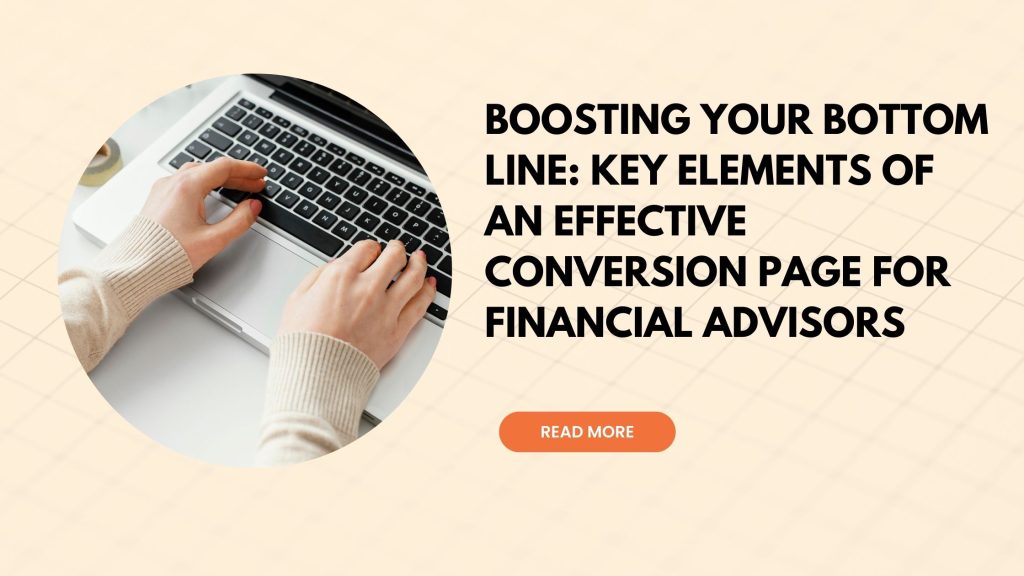In the fast-paced world of finance, attracting clients is just half the battle; converting them into loyal customers is where the magic truly happens. As a financial advisor, your conversion page serves as the digital storefront where potential clients get their first impression of your services—and we all know how crucial that first impression can be! But what makes a conversion page not just good, but exceptional? In this blog post, we’ll dive deep into the key elements that transform ordinary landing pages into powerful tools for boosting your bottom line. From persuasive copy and compelling visuals to trust-building testimonials and clear calls to action, we’ll equip you with actionable insights aimed at turning curious visitors into committed clients. Get ready to supercharge your online presence and watch your client base flourish!
Introduction to the importance of a conversion page for financial advisors
As a financial advisor, your primary goal is to attract clients and grow your business. But have you ever considered how essential a well-crafted conversion page on your website can be? This often-overlooked element could hold the key to turning casual visitors into loyal clients. A strong conversion page doesn’t just showcase your services; it guides potential clients through their journey, helping them understand why they need your expertise.
In today’s digital landscape, where every click counts, having an effective conversion page is non-negotiable. It’s not merely about aesthetics; it’s about strategy and psychology. By understanding what makes a compelling conversion page for financial advisors, you’ll be equipped to boost engagement and ultimately enhance your bottom line.
Key elements of an effective conversion page:
A compelling headline grabs attention instantly. It should convey the value of your services in a few impactful words. Pair it with a subheadline that elaborates on the promise, enticing visitors to stay.
Next, a clear call-to-action is essential. Use actionable language that directs readers toward the next step—be it scheduling a consultation or signing up for newsletters.
Your content must be relevant and valuable. Address specific pain points faced by potential clients. Offer insights into how you can solve their financial dilemmas effectively.
Incorporating testimonials builds trust. Showcase social proof from satisfied clients to reinforce credibility.
Finally, design plays a crucial role in user experience. Ensure navigation is intuitive and visually appealing so visitors can easily find what they need without frustration.
– Compelling headline and subheadline
Your headline is the first thing visitors see. It needs to grab their attention immediately. A compelling headline sparks curiosity and encourages further reading.
Think of it as your digital handshake—a warm welcome that sets the tone for what’s to come. Use powerful words that resonate with your target audience, whether they’re looking for retirement planning or investment advice.
The subheadline supports this by providing more context. It should clarify the main benefit of engaging with you. This could be a promise of financial security or peace of mind.
Make sure both elements are clear and concise. Avoid jargon; keep it simple yet impactful. The combination captures interest and gives potential clients a reason to stay on your conversion page longer, enhancing engagement right from the start.
– Clear call-to-action
A clear call-to-action (CTA) is crucial for any conversion page on a financial advisor’s website. It guides visitors toward taking the desired action, whether that’s scheduling a consultation or downloading an informative guide.
Your CTA should be specific and easy to follow. Use action-oriented language that inspires immediate response, such as “Get Your Free Consultation” or “Download Our Investment Guide.”
Placement matters too. Ensure your CTA stands out visually—consider using contrasting colors or bold fonts to draw attention.
Additionally, keep it above the fold so visitors don’t have to scroll extensively to find it. If they can see what you want them to do right away, they’re more likely to engage.
Lastly, test different versions of your CTA text and design over time. This small adjustment can lead to significant improvements in conversion rates and ultimately boost your bottom line.
– Relevant and valuable content
Relevant and valuable content is the backbone of any effective conversion page on a financial advisor’s website. It addresses the specific needs and concerns of your target audience. Providing insights into investment strategies, retirement planning, or tax optimization can resonate deeply with potential clients.
This type of content should be easily digestible. Use bullet points, short paragraphs, and visuals to break up text. When people see that you understand their challenges and can offer solutions, they are more likely to engage.
– Testimonials and social proof
Testimonials and social proof are powerful tools for building trust. When potential clients see positive feedback from others, it creates a sense of reliability. A well-placed testimonial can speak volumes about your services. It reassures visitors that they are making the right choice by considering you as their advisor.Consider using video testimonials or written ones with client photos. These add authenticity and make connections more personal. Social proof extends beyond just words; it’s about showcasing achievements too. Highlight any awards you’ve received, media mentions, or certifications on your conversion page.This not only enhances your reputation but also reinforces confidence in prospective clients’ decisions to reach out to you for assistance with their finances.
– User-friendly design
User-friendly design is crucial for a conversion page on a financial advisor’s website. It ensures that visitors can easily navigate and find the information they need without feeling overwhelmed.
A clean layout with ample white space improves readability, allowing potential clients to focus on your message. Intuitive navigation helps them explore services effortlessly.
Incorporating responsive design also plays a vital role in user experience. A seamless transition between devices means potential clients can reach out from their phones or tablets just as easily as from their desktops.
Tips for optimizing your conversion page:
Optimizing your conversion page is essential for attracting and retaining potential clients. Start with A/B testing different elements, such as headlines or calls-to-action. This helps you identify what resonates best with your audience.
Make sure your page is mobile-responsive. Many users browse on their phones, so a seamless experience across devices can significantly increase engagement.
Simplifying the process is key to reducing friction. Use clear forms that are easy to fill out, eliminating unnecessary fields that might deter users from completing them.
Consider loading speed as well; slow pages can lead to high bounce rates. Optimize images and minimize code for quicker access.
Lastly, always keep an eye on user analytics. Understanding how visitors interact with your page will inform further tweaks and enhancements over time.
– A/B testing
A/B testing is a powerful tool that can significantly enhance your conversion page on a financial advisor’s website. This method involves comparing two versions of the same page to see which one performs better. Start by changing one element at a time, such as the headline or call-to-action button color. This way, you can clearly determine what impacts user behavior.
Collect data over time to validate your findings. The metrics you choose—like click-through rates or form submissions—will guide future tweaks and improvements. Remember, even small changes can lead to substantial gains in conversions. You might be surprised at how much an altered phrase or different layout design influences visitor actions.
– Mobile responsiveness
Mobile responsiveness is crucial for any conversion page on a financial advisor’s website. Today, more clients are browsing and making decisions on their smartphones or tablets. If your site isn’t optimized for mobile, you risk losing potential leads.
A responsive design adjusts seamlessly to different screen sizes. This ensures users have a pleasant experience regardless of the device they choose. It enhances readability and navigation, leading to higher engagement levels.
Moreover, search engines prioritize mobile-friendly sites in their rankings. This means that having an effective conversion page not only attracts visitors but also improves your visibility online.
Incorporating touch-friendly buttons can make interactions easier for users on smaller screens. A streamlined layout reduces clutter and guides them toward taking action without distraction.
With so many people accessing information on-the-go, ensuring your conversion page is fully responsive is no longer optional; it’s essential.
– Simplifying the process
Simplifying the process is crucial for turning visitors into clients. A complex user journey can lead to frustration and abandonment. Your conversion page should facilitate easy navigation.
Start by minimizing the number of steps needed to complete an action. Whether it’s filling out a form or scheduling a consultation, streamline each task. Use clear labels on buttons and fields so users know exactly what to do next.
Consider implementing multi-step forms that break information requests into bite-sized sections. This reduces overwhelm and increases completion rates.
Additionally, eliminate unnecessary distractions from your conversion page. Avoid cluttering it with excessive information or links that could divert attention away from your primary goal.
A straightforward design speaks volumes about your professionalism as a financial advisor. Make every click count towards guiding potential clients through their decision-making process effortlessly.
Common Errors To Avoid When Creating a Conversion page
- Your headline needs to grab attention immediately. A bland title can turn potential clients away.
-
Overwhelming visitors with too much information. Keep content concise and focused on key benefits. Clarity trumps quantity every time.
-
Ignoring mobile optimization can be detrimental too. Many users browse on mobile devices, so your conversion page must be responsive and easy to navigate.
-
Make sure your CTAs stand out visually and use action-oriented language that encourages clicks.
-
Don’t overlook the power of social proof. Testimonials build trust but should be authentic and relevant rather than generic or overly promotional.
Conclusion: The impact of a well-designed conversion page on your bottom line as a financial advisor.
A well-designed conversion page is more than just a tool—it’s a powerful driver of growth for your financial advisory business. By guiding potential clients through a clear and compelling user journey, you can significantly increase the likelihood of turning visitors into valuable leads. This not only boosts your client base but also directly impacts your bottom line by enhancing your revenue potential. Investing time and resources into creating a conversion-focused page is an investment in your business’s future success.

